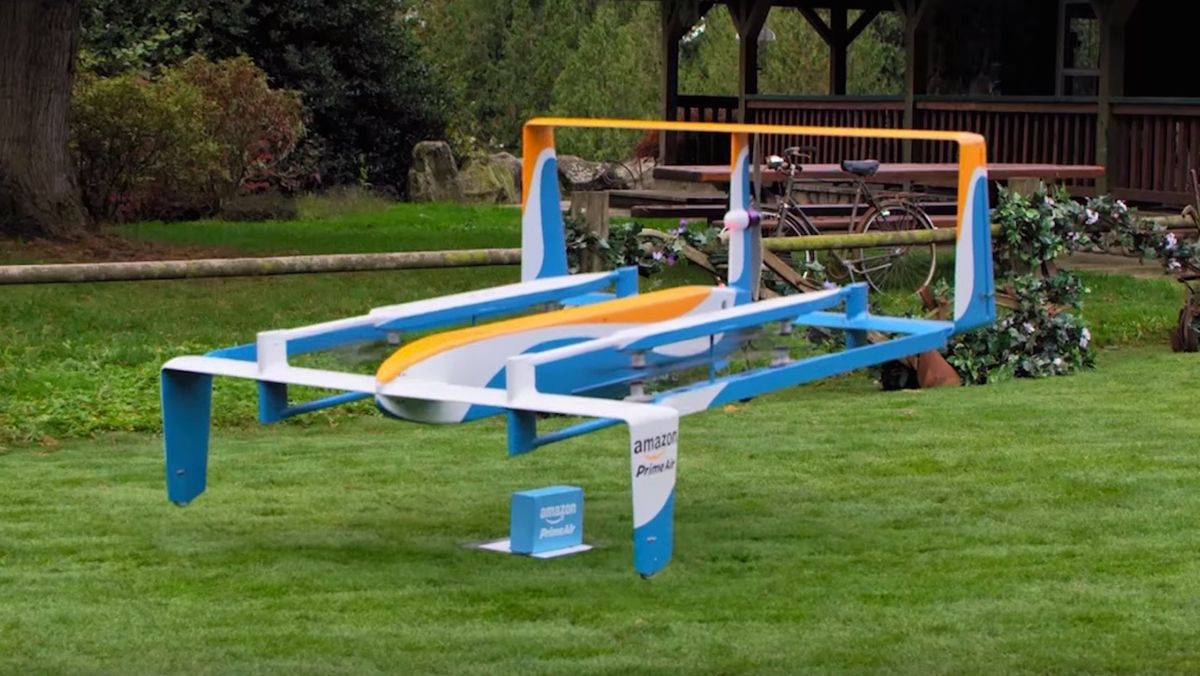Whether or not it’s a realistic or practical or good idea, urban commercial drone delivery is grinding remorselessly toward a thing that is going to happen. For many companies, “grind” is the right word, especially if they’re trying to do research and development in the United States, where regulations tend to be overly cumbersome and inflexible. To help move things along a bit, Amazon has decided to take its next phase of delivery drone testing to the United Kingdom.
Here’s the stuff worth caring about from the press release, which amounts to about a third of the press release. In other words, it’s relatively informative, as press releases go:
Amazon has today announced a partnership with the UK Government to explore the steps needed to make the delivery of parcels by small drones a reality, allowing Amazon to trial new methods of testing its delivery systems.
A cross-Government team supported by the UK Civil Aviation Authority (CAA) has provided Amazon with permissions to explore three key innovations: beyond line of sight operations in rural and suburban areas, testing sensor performance to make sure the drones can identify and avoid obstacles, and flights where one person operates multiple highly-automated drones.
This ground-breaking work will help Amazon and the Government understand how drones can be used safely and reliably in the logistics industry. It will also help identify what operating rules and safety regulations will be needed to help move the drone industry forward.
There are three things that are worth talking about here:
Thing 1: Obstacle avoidance is still not solved.
Admittedly, I’m reading between the lines and making some assumptions, but I still have no reason to believe that Amazon has managed to solve the problem of navigating drones autonomously around trees, power lines, people, and pets. This is what continues to bug me about how Amazon presents Prime Air: “Prime Air vehicles will take advantage of sophisticated ‘sense and avoid’ technology, as well as a high degree of automation, to safely operate beyond the line of sight to distances of 10 miles or more.” The operative word here is “will.” Eventually. They hope.
Thing 2: Amazon will keep humans in the loop.
Near-term, I have serious doubts about Amazon’s “sophisticated sense and avoid technology” and “high degree of automation.” If they’re trying to deliver useful payloads and do onboard sense and avoid at the same time over a practical distance using hardware that they can cost-effectively manufacture and deploy at scale, as far as I know they’ve still got a lot of work to do. The only thing to do is, as the press release says, keep a human in the loop to do the challenging bits rather than relying on tech that may not usefully exist yet.
What I think is going to happen is that Amazon will have its drones take off autonomously and fly along premapped safe corridors at altitude using GPS plus some (relatively) primitive vision systems that allow the drone to avoid really obvious things like hot-air balloons.
Once the drone reaches its final GPS waypoint, it’ll use cellular networks to ping a call center staffed with drone pilots, and then a human will take over for the actual delivery part using a streaming video interface. Once the delivery is complete and the drone is at altitude again, it’ll return autonomously, and the human pilot can move on to another drone waiting for help. Taking the tricky bits away from the autonomous system is probably the right thing to do, and the only realistic way for Amazon to get anywhere close to what they’ve been promising people.
Thing 3: It’s really annoying to try to deploy autonomous commercial robots in the United States right now.
The U.S. Federal Aviation Administration and National Transportation Safety Board are making credible efforts towards developing frameworks for drones and cars, but they’re part of that massive and unwieldy bureaucracy that the good old U.S. of A. is so well known for. There are either no regulations, or too many regulations, or contradictory regulations, or all of those things at the same time, which doesn’t seem like it should be possible but somehow is anyway. We’re seeing more and more companies who want to seriously tackle commercial autonomy just throw up their hands and start testing in Canada, Asia, or Europe, because those are places where they can actually get stuff done.
[ Amazon ]
Evan Ackerman is a senior editor at IEEE Spectrum. Since 2007, he has written over 6,000 articles on robotics and technology. He has a degree in Martian geology and is excellent at playing bagpipes.



